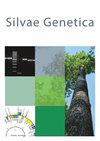Cooperative Second-Cycle Breeding and Testing of Coastal Douglas-fir in the US Pacific Northwest: Strategy, Implementation, and Operational Aspects
IF 1
4区 农林科学
Q3 FORESTRY
引用次数: 1
Abstract
Abstract The second cycle of cooperative breeding and testing of coastal Douglas-fir in western Oregon and Washington was started around 1992. By 2020 the bulk of testing is nearing completion, while the latest program in southern Oregon and NW California is scheduled to run through 2035. A total of 109 first-generation programs were consolidated into nine second- cycle breeding and testing cooperatives (with 15 testing zones); 136 tests are planned, of which 120 have already been established. Between five and eight tests are established per trial series. Trials established to date have contained from 50 to 283 full-sib crosses. In total, the Douglas-fir breeding effort will be comprised of over 2,900 crosses, of which 2,500 have already been established in the field. A total of about 349,000 test trees are to be planted, with over 310,000 already planted. Tests typically get three main measurements when the trees are 3 (or 4), 7 and 12 years old from seed. (1) Age-3 or 4: progression of budburst, on a 1 to 5 rating score, when roughly 50 % of the seedlings have broken bud, on one or two sites per trial series. (2) Age-7: height (height pole), dbh, stem sinuosity in the second internode from the top, number of incidences of stem forking, number of incidences of ramicorn branching and (3) Age-12: height (vertex), dbh, stem sinuosity in the second internode from the top, number of incidences of stem forking, number of incidences of ramicorn branching, second flushing yes\no in current year, and wood acoustic velocity (in some trial series).美国西北太平洋沿岸道格拉斯冷杉第二周期合作育种和试验:战略、实施和操作方面
1992年前后,俄勒冈州西部和华盛顿州沿海道格拉斯冷杉的第二轮合作育种和试验开始。到2020年,大部分测试将接近完成,而俄勒冈州南部和加利福尼亚州西北部的最新项目计划持续到2035年。109个第一代项目被合并为9个第二周期育种和检测合作社(15个试验区);计划进行136项测试,其中120项已经确定。每个试验系列建立5到8个试验。迄今建立的试验包含50至283个全同胞杂交。总的来说,道格拉斯冷杉育种工作将包括2900多个杂交品种,其中2500个已经在野外建立。总共将种植34.9万棵试验树,目前已经种植了31万多棵。当树木从种子开始生长到3岁(或4岁)、7岁和12岁时,测试通常会进行三种主要测量。(1) 3岁或4岁:芽出的进展,评分为1到5分,当大约50%的幼苗已经破芽时,每个试验系列在一个或两个地点进行。(2)年龄-7岁:株高(高极)、胸径、从上至下第二个节间的茎弯数、茎弯数、分枝数;(3)年龄-12岁:株高(顶点)、胸径、从上至下第二个节间的茎弯数、茎弯数、分枝数、当年二次冲是/否、木材声速(部分试验系列)。
本文章由计算机程序翻译,如有差异,请以英文原文为准。
求助全文
约1分钟内获得全文
求助全文
来源期刊

Silvae Genetica
农林科学-林学
CiteScore
2.20
自引率
10.00%
发文量
10
审稿时长
3 months
期刊介绍:
Silvae Genetica is an international peer reviewed journal with more than 65 year tradition and experience in all fields of theoretical and applied Forest Genetics and Tree breeding. It continues "Zeitschrift für Forstgenetik und Forstpflanzenzüchtung" (Journal of Forest Genetics and Forest Tree Breeding) founded by W. LANGNER in 1951.
 求助内容:
求助内容: 应助结果提醒方式:
应助结果提醒方式:


